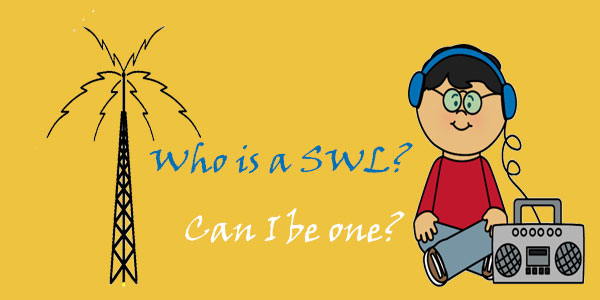What is a SWL? Can I be one?

What is a SWL? Can I be one?
Most people start off as a short wave listener, listening to amateur radio bands, getting to know the ham lingo and much more, keeeping pace with all the latest news in the world of amateur radio. A Short Wave Listener (SWL) needs no license (ofcourse you can take an SWL License but you can even do without it), passes no test and goes about amateur radio as he pleases. A desultory begining often leads to awakening interest, some constructional work, further study and a developing awareness of the activity. The serious SWL will soon accumulate a substantial knowledge of the results to be anticipated at various frequencies, depending on time of the day, season and a knowledge of propagation as it affects short wave transmission. This greatly helps in obtaining the kind of results wanted.This is a start on the way to obtaining a full transmitting license, which is the eventual aim of many short wave listeners.
But where do I begin?
To start off with, you need a recevier (short wave radio) capable of receiving amateur radio bands. Most of us have ordinary radios. Normally most of the good radios that you find around are capable of receiving the 40m (7 MHz) amateur radio band. All you need to do is bring the dial near 40m and try tuning in a very slow manner. Be patient! When you are around 7 to 7.2 MHz you will most probably be able to hear real people talking. It depends on the time of the day, you are trying to listen to. Most hams prefer to come on air in the mornings and evenings.
If you are lucky enough you will get to hear hams talking on amplitude modulation(AM). You will be able to properly decode what they are speaking if you actually get them on AM. Most hams use the SSB mode. If you have already tried listening to ham radio conversations on your ordinary short wave radio then you should have come across the quack-quack kind of human conversations. This mode known as SSB enables hams to communicate over longer distances than when they are on AM.
If you have a really good communication receiver like the Sony ICF range of radios, you can actually decode SSB reception. But don't worry, we can actually manage with a normal short wave radio. For listening to an SSB signal you will have to make a (Beat Frequency Oscillator).
Indian Institute of Hams do conduct workshops on SDRs or Software Defined Radios, with which you can actually listen to hams on all modes with the help of your computer. You even have the choice of listening to an online SDR receiver. All you need is a web browser for you to tune into the 40M (7 Mhz) ham band by visiting the following link
You can even download the software from Ham Sphere and listen to live converations from around the world.
